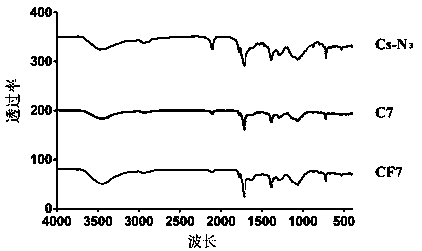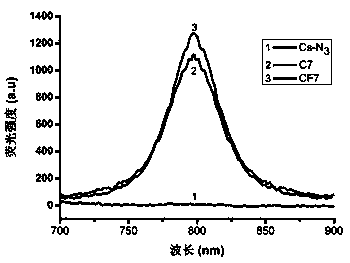A kind of folic acid-chitosan-cy7 polymer with tumor targeting and preparation method thereof
A technology of tumor targeting and chitosan derivatives, which is applied in the field of biomedicine and can solve problems such as poor solubility of chitosan
- Summary
- Abstract
- Description
- Claims
- Application Information
AI Technical Summary
Problems solved by technology
Method used
Image
Examples
Embodiment 1
[0043] Synthesis of Polymer CF7:
[0044] Step a: Weigh 800 mg of chitosan and dissolve in 60 mL of anhydrous DMF, then add 1.6 g of phthalic anhydride, under nitrogen protection, stir and heat in an oil bath at 120°C. When the reaction solution became clear, the reaction was terminated. The reaction solution was poured into an appropriate amount of ice water, and a white precipitate was precipitated. After suction filtration, the solid was washed three times with ether and acetone respectively to remove excess phthalic anhydride, and dried to obtain product 2.
[0045] Step b: Weigh 100 mg of product 2, add 10 mL of N-methylpyrrolidone (NMP), heat and stir to dissolve. When the solution was cooled and placed in ice water, 616 mg N-bromosuccinimide (NBS) and 902 mg triphenylphosphine (TPP) were added. React at 80°C for two hours under nitrogen protection. After the reaction was over, the mixture was poured into 100 mL of ethanol, and a solid was precipitated. The product ...
Embodiment 2
[0049] Synthesis of Chitosan-Cy7 Polymer (C7):
[0050] Weigh 10 mg of the product 4 of Example 1, dissolve it in 5 mL of dimethyl sulfoxide, and add 10 mg of ALK-Cy7. The flask was sealed with a rubber stopper and protected with nitrogen after evacuation. First add 2.5 mg copper sulfate pentahydrate (dissolved in 100 μL secondary water) dropwise to the flask with a 1 mL syringe, and then add 2 mg sodium ascorbate (dissolved in 100 μL secondary water) dropwise. The reactants were reacted at 50 °C for 72 h in the dark. After the reaction, the reaction solution was dialyzed for 72 hours with a 14000 dialysis bag. After dialysis, the product was lyophilized. According to infrared spectrogram analysis, the 6-position azido group in product 4 reacted with the alkynyl group in ALK-Cy7 to form a triazole ring. Such as figure 1 As shown, chitosan-Cy7 polymer (C7) at 2100 cm -1 There is no infrared absorption peak, indicating that the azido group has successfully reacted with th...
Embodiment 3
[0052] Synthesis of chitosan-FA polymer (CF):
[0053] Weigh 10 mg of the product 4 of Example 1, dissolve it in 5 mL dimethyl sulfoxide, and add 10 mg ALK-FA. The flask was sealed with a rubber stopper and protected with nitrogen after evacuation. First add 2.5 mg copper sulfate pentahydrate (dissolved in 100 μL secondary water) dropwise to the flask with a 1 mL syringe, and then add 2 mg sodium ascorbate (dissolved in 100 μL secondary water) dropwise. The reactants were reacted at 50 °C for 72 h in the dark. After the reaction, the reaction solution was dialyzed for 72 hours with a 14000 dialysis bag. After dialysis, the product was lyophilized. According to infrared spectrogram analysis, the azido group at position 6 in product 4 reacted with the alkynyl group in ALK-FA to form a triazole ring. Such as figure 1 As shown, chitosan-FA polymer (CF) at 2100 cm -1 There is no infrared absorption peak, indicating that the azido group has successfully reacted with the alkyn...
PUM
 Login to View More
Login to View More Abstract
Description
Claims
Application Information
 Login to View More
Login to View More - R&D
- Intellectual Property
- Life Sciences
- Materials
- Tech Scout
- Unparalleled Data Quality
- Higher Quality Content
- 60% Fewer Hallucinations
Browse by: Latest US Patents, China's latest patents, Technical Efficacy Thesaurus, Application Domain, Technology Topic, Popular Technical Reports.
© 2025 PatSnap. All rights reserved.Legal|Privacy policy|Modern Slavery Act Transparency Statement|Sitemap|About US| Contact US: help@patsnap.com



